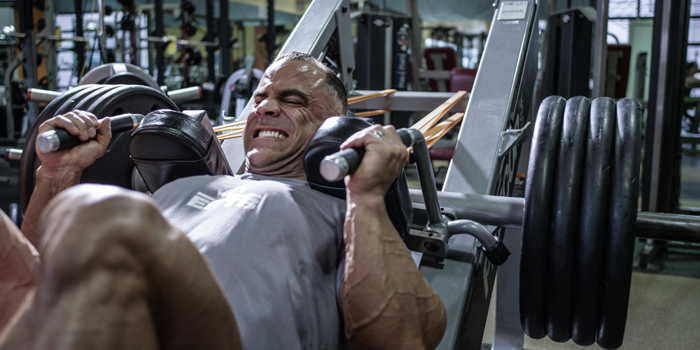
I realize its cliché, but the only constant in life is change. That holds true for me in the gym as well. I’ve been doing John Meadows' programs for the better part of four years now. I credit him with resuscitating my physique at a time when high-intensity training ran its course and did more harm than good to my body. Coincidentally, the two big takeaways from the past four years are that training frequency isn’t as evil as I once thought, and that properly applied volume provides a safer loading parameter than simply adding more weight.
RECENT: The Danger of Disposability
I’m now into my 40's, so if you’re from my generation or older with any appreciable amount of training time under your belt, you know that our approach to training must change with time. What works in your 20's likely isn’t going to suit you well two decades later. There’s also value in reading this article if you’re a 20 or 30-year-old because the intensity principles I’m about to share might very well fast-track your growth and prolong your training days.
The 80’s
I loved this decade, in part because it reminds me of my impressionable, early teen years where the world was big and problems were small. Things just seemed simpler. The 80’s arguably marked the origin of some of the most inventive music and fashion. It’s also the decade in which I saw Arnold Schwarzenegger — not in-person, but in the 1982 action movie Conan the Barbarian. This film ushered in my quest for muscle.
It’s funny how various forms of 80’s fashion and music influences begin to recycle. The same thing often occurs with diets and training methods. I confess six-inch tall Aqua Net bangs capable of withstanding Hurricane Irma are best left in the 80’s, but I recently stumbled upon a gentleman and his training methods from this decade that warrants consideration.
Vince Gironda
Known as the Iron Guru, Vincent “Vince “Gironda was an American professional bodybuilder, personal trainer, author, and owner of the celebrity-frequented Vince's Gym. He lived from 1917 to 1997 and his approach to low carb diets and training, much like 80’s fashion, is widely making its rounds again.
What intrigues me most stems from Vince’s analytical approach to training and his very clear distinction between bodybuilding and lifting weights. I continue to learn the value of thinking outside the box and training for an illusion onstage rather than pounds on a bar. Successful natural trainers (Vince’s claim) tend to pique my interest more because they’re forced to progress via their intellectual prowess and hard work rather than reliance on drugs.
Maximizing Hypertrophy
Training to failure triggers adaptation and subsequent muscle growth. Early on I knew only one method: load pounds on a bar until you hit failure in the six to eight rep range, performing the fewest sets possible. Chasing pounds eventually returned negative results from a purely bodybuilding standpoint.
Next, I learned volume provided a stimulus whereby after multiple sets of the same weight I eventually hit failure. Volume allowed me to lower the amount of weight I lifted because the approach of performing multiple sets led to the same point of failure, albeit with a safer training method.
Frequency advanced hypertrophy, allowing me to cut marathon workouts down to multiple sprints. If training is anabolic and proper recovery is achieved, why not train as often as possible to reap the most anabolic results?
With Vince, I tapped into the training technique most often attributed to him: density training. At the most basic level, it is astoundingly simple. Do as much work as possible within a short period of time, ideally in the 60-minute range. The go-to program most often looked like eight sets of eight reps with the same weight, and anywhere from 15 to 30 seconds of rest between sets, but Vince also utilized superset or giant set circuits.
My Training Split
Inspired by John’s primary and secondary workouts, I still train five days per week. Circling back and expanding upon my previous comments, frequency and volume/density are better loading parameters than simply adding pounds to a bar. To define better, I mean improved safety. You can’t train and grow if you’re hurt. Frequency and work density provide equal muscle adaption response and more favorable body composition.
Here is a look at my current training split:
- Sunday — Chest, Shoulders, and Triceps
- Monday — Back and Biceps
- Tuesday — HIT Cardio
- Wednesday — Chest, Shoulders, and Triceps
- Thursday – Back and Biceps
- Friday — Off
- Saturday — Legs
To give you an idea of some exercises to which I applied a Gironda-style approach, check out these videos:
Guillotine Press
Alternating — Hamstring Curls/Chains
Triset — Back Circuit
Alternating — Occluded Legs
Triset — MAG Back Circuit
If you’re like me — pressed for time and required to work with lighter weight — I recommend test-driving some of Vince’s density training. For more details visit my training logs.












I hope you're doing well brother. I basically took legs back to 1 day per week because my lower back is typically jacked for 2-3 days after training legs. Training twice per week left me crippled nearly all week. That said, I recently began learning ways to nail my quads without messing up my back. For now I'm leaving my leg training at once per week because it doesn't seem to be hindering my development.
I'm pretty much cardio-adverse, lol. The HIIT air bike session falls on the day I formerly reserved for my secondary leg day. I do that an then hit the dry sauna. It's the only cardio I do off-season which is actually more than I did during my last contest prep in the spring. Pre-contest I did zero cardio. I just get the job done with diet.
I hope this helps.
Mark
I am a long time follower of your articles and I often reference your training logs for inspiration for a lot of alternatives to certain exercises I feel are hurting more than helping me. I want to ask you a couple questions if you don't mind reading and supplying answers to when you get the chance.
Context: I am a former D1 college athlete (5 years removed), currently not involved in sports now. I've been in the gym, like many athletes, since a very young age. I'm 28 now, I've been through a couple surgeries, the most recent being an arthroscopic hip labral repair a few years back. Just a year ago I competed in my first bodybuilding comp and placed 2nd in my class. I did not completely enjoy the process of getting to stage shape, but I didn't enjoy looking and feeling the way I did.
Fast forward: This year, I've just let that discipline go, in the kitchen and in the gym. Just feels like I needed to step away. However, I've been wanting to re-establish that discipline and some motivation to be consistent in my diet and gym times but I've been having a lot of pain in my hip from arthritis and learned this year from my appointment with my surgeon that I could use a partial hip replacement or steroid injections. So the idea of lifting heavy again (at least squatting heavy) is in the trash. I'm kind of ok with that.
My questions:
1. You have a lot of workouts that you've found to work around your injuries, I really appreciate that and use the same workouts you post. My lower back, hips, left knee, and groin all hate me. Have any of your injuries and realizations of limits caused your motivation to sway a bit? If so, how did you find your way back on track?
2. Do you find that after a competition you are more or less ready to jump back into training for the next competition or do you take a complete hands-off break from the weights?
3. Has there been any time in your life when you just didn't feel like being that "gains" state of mind and found yourself stepping away from the weights and your lifestyle (as we perceive on this website) and have a hard time making your way back? If so, what were a few things that really helped you get back on track and be all around consistent again?
Hey, I understand this is a lot of questioning and I don't expect an answer. I mostly just wanted to say thank you for your content and contribution. When I do make it in the gym, I fall back on your routines to get me going and excited to make it to the finish line for the day.
Thanks,
Jay
First, thank you for your support. I'm grateful to hear you're finding value in my training logs. Age and injuries suck, but alas...we keep going. To answer your questions...
1. Yes, not being able to exercises you once enjoyed or lift the weight you previously lifted can be disheartening. I felt like quitting when I could no longer squat. The thing is that I still really love to train and I simply found other ways to challenge myself. I think that's the key to why I keep going back - the challenge.
2. No, I really never take a break from training. It's in my blood and is my form of stress release. I simply feel better and function better at work and in life when I workout. That isn't to say I don't back off the weight or volume post-contest, but I never really quit working out.
3. To some extent, I've already given up the "gains" mentality. I lift different, I don't force feed and ultimately I care more about impressing my wife naked than I do a judging panel. I want to look good, feel good and be healthy. Chasing mass is overrated, but again I never really stop training.
It sounds like you might benefit from someone like John Meadows. His programming is always changing and makes workouts more exciting. He really helped me several years back. Just something to consider as variety and challenge is what keeps things interesting.
I hope this helps.
All the best,
Mark